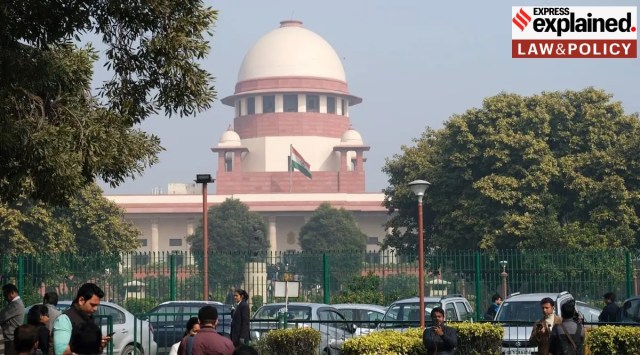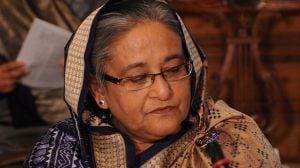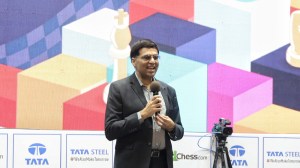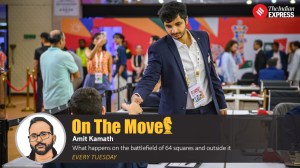Ananthakrishnan G. is a Senior Assistant Editor with The Indian Express. He has been in the field for over 23 years, kicking off his journalism career as a freelancer in the late nineties with bylines in The Hindu. A graduate in law, he practised in the District judiciary in Kerala for about two years before switching to journalism. His first permanent assignment was with The Press Trust of India in Delhi where he was assigned to cover the lower courts and various commissions of inquiry. He reported from the Delhi High Court and the Supreme Court of India during his first stint with The Indian Express in 2005-2006. Currently, in his second stint with The Indian Express, he reports from the Supreme Court and writes on topics related to law and the administration of justice. Legal reporting is his forte though he has extensive experience in political and community reporting too, having spent a decade as Kerala state correspondent, The Times of India and The Telegraph. He is a stickler for facts and has several impactful stories to his credit. ... Read More
Landmark Article 370 verdict coming: here’s what happened in Supreme Court during hearings
On Monday (December 11), the Supreme Court will deliver its verdict on petitions challenging the Centre’s decision to make changes to Article 370, and reorganise the state into the two Union Territories of J&K and Ladakh. Here are some of the key arguments of the petitioners.
 After a 16-day hearing, during which it considered submissions for and against the Centre’s August 2019 move, the Supreme Court had reserved its decision on September 5 this year. (Photo: Bloomberg Photo/File)
After a 16-day hearing, during which it considered submissions for and against the Centre’s August 2019 move, the Supreme Court had reserved its decision on September 5 this year. (Photo: Bloomberg Photo/File)Was Parliament within its powers to make changes to Article 370 of the Constitution and take away Jammu and Kashmir’s special status, or could it only have been done on the recommendations of the Constituent Assembly of the erstwhile state?
On Monday (December 11), the Supreme Court will deliver its verdict on petitions challenging the Centre’s decision to make changes to the provision, and reorganise the state into the two Union Territories of J&K and Ladakh.
After a 16-day hearing, during which it considered submissions for and against the Centre’s August 2019 move, the Supreme Court had reserved its decision on September 5 this year. Chief Justice of India (CJI) D Y Chandrachud presided over the Bench, which also comprised the four other most senior judges of the court — Justices S K Kaul, Sanjeev Khanna, B R Gavai, and Surya Kant.
Here are some of the key arguments of the 23 petitioners, the contentions of the Centre and J&K administration, and statements made by the Constitution Bench.
What the petitioners argued
TEMPORARY PROVISION THAT BECAME PERMANENT: Article 370 was meant to be temporary until the constituent assembly for J&K which existed from 1951 to 1957, took a decision on whether to abrogate it. Since no decision was taken, it became permanent. Thereafter, there was no constitutional process left to touch Article 370 and changes, if any, could only have been made through a political process.
The main issue to be decided is whether Parliament could have assumed the role of the constituent assembly to make the amendments. Parliament could not have converted itself into a Constituent Assembly. Accepting that it can do so, will have enormous consequences for the future of the country. It was done in a politically motivated manner, and was a fraud on the Constitution.
ACCESSION & INTERNAL SOVEREIGNTY: J&K historically had a unique relationship with the Union. There was no merger agreement between J&K and the Union, but only the Instrument of Accession (IoA). Hence there is no transfer of sovereignty, and the state’s autonomy has to be maintained. The IoA deals with external sovereignty. External sovereignty is lost with a few exceptions here and there, but internal sovereignty is not lost.
CONCURRENCE OF THE J&K GOVT: Article 370 provided limitations regarding the power of Parliament to make laws for J&K. To make laws on a subject in List I (Union List) or List III (Concurrent List), which is not covered by the IoA, concurrence of the state government, which means concurrence of the people of the state via the Council of Ministers, is needed.
ROLE OF THE GOVERNOR: The J&K Governor could not have dissolved the Legislative Assembly without the aid and advice of the Council of Ministers.
REORGANISATION, DOWNGRADING TO UT NOT PERMISSIBLE: The proviso to Article 3 dealing with “formation of new States and alteration of areas, boundaries or names of existing States”, makes it mandatory for the President to refer the Bill for reorganisation of a state to the legislature. But the consent of the J&K Legislative Assembly was not taken before introducing the reorganisation Bill. A state cannot be extinguished and converted into a UT — that is contrary to all principles of the representative form of government.
NOTHING TO SHOW THAT ARTICLE 370 FAILED: Article 370 integrates J&K with India. It is not the Centre’s case that it has not worked for the last seven decades. There is no example to show that it failed, and it is therefore unfathomable why it was done overnight. The only material before the Centre was the BJP’s 2019 election manifesto that promised the abrogation of Article 370.
What the Centre contended
DUE PROCESS WAS FOLLOWED: Arguments that the manner in which the presidential proclamations were issued were a fraud on the Constitution, are completely misconceived. There was no deviation from due process.
SOVEREIGNTY WAS SURRENDERED: The erstwhile state of J&K had fully surrendered its sovereignty to the Union of India upon accession. The petitioners are confusing internal sovereignty with autonomy.
KARAN SINGH’S PROCLAMATION: The proclamation issued by Karan Singh, son of J&K’s then ruler Hari Singh, on November 25, 1949, said that the Government of India Act, 1935, which until then governed the Constitutional relationship between J&K and the dominion of India, will stand repealed.
It stated that the “Constitution of India shortly to be adopted by the Constituent Assembly of India shall, in so far as it is applicable to the State of Jammu and Kashmir, govern the Constitutional relationship between this State and the contemplated Union of India and shall be enforced in this State by me, my heirs and successors in accordance with the tenor of its provisions”, and “the provisions of the said Constitution shall, as from the date of its commencement, supersede and abrogate all other constitutional provisions inconsistent therewith which are at present in force in this State.”
This is beyond any IoA or merger; it is accepting the supremacy of the Indian Constitution and surrendering sovereignty to it, where the sovereign is ‘We the people of India’.
THERE CAN’T BE TWO CONSTITUTIONS: Unlike the Constituent Assembly formed for drafting the Indian constitution, the J&K Constituent Assembly was not a plenary Constituent Assembly — because by that time sovereignty had already been merged. There cannot be two Constitutions. This furthers the point that the words “Constituent Assembly” in Article 370(3) can be read only as ‘Legislative Assembly’.
UT TEMPORARY, BUT RETURN OF STATEHOOD MAY TAKE TIME: UT status for J&K is temporary, but no specific timeline for restoration of statehood can be provided. This is because of the peculiar circumstances the state has passed through with repeated and consistent disturbances over decades.
Comments and queries by Bench
ON THE POSITION OF ARTICLE 370 IN THE CONSTITUTION: If Article 370 became permanent after 1957, why was it then placed in Part XXI of the Constitution which deals with “temporary, transitional and special provisions”? If it became permanent, does that mean there is a provision of the Constitution, besides the basic structure, which lies even beyond the amending power of Parliament? Sub-clause 3 of Article 370 envisages a process by which it can be de-operationalised; thus, it is very difficult to propose that Article 370 has such a permanent character that it can never be amended.
ON THE WAY TO SEEK PEOPLE’S OPINION: In a constitutional democracy, the opinion of the people has to be sought through established institutions. Within a Constitution like ours, there is no question of a referendum.
ON ARTICLE 370 AND ARTICLE 1: The question is whether Parliament in the exercise of its powers under Article 368 to amend the Constitution, can amend Article 370.
Transfer of sovereignty to the dominion of India by acceding states, including Jammu and Kashmir, was not conditional but absolute, as is reflected in Article 1 of the Indian Constitution. The Constitution (Application to Jammu and Kashmir) Second Amendment Order, 1972, which amended Article 248 in relation to its application to J&K “makes it now beyond the pale of doubt that sovereignty vested exclusively in India and, therefore, no vestige of sovereignty was retained post the Instrument of Accession (IoA)”.
The reference to Article 1, a permanent feature of the Constitution of India, in Article 370 is “a clear indicator” that the latter was “never intended to be permanent”.
ON THE COMPETENCE OF PARLIAMENT: Does the fact that Parliament can’t touch a State List item while enacting a law, retract from the fact that all these states ceded sovereignty to the dominion of India? Restraint on the power to enact legislation is implicit in the scheme of the Constitution.
The argument that Article 370 became permanent after the J&K Constituent Assembly ceased to exist in 1957 is belied by the practice of issuing the Constitution (Application) Orders from time to time, modifying the Constitution in relation to the erstwhile state.
ON HOW LONG THE UT CAN EXIST: “Should we not permit Parliament to postulate that for a certain period, in interest of the preservation of the nation itself…this particular state shall go in the fold of UT, on the clear understanding that this shall revert back to a State?”



- 01
- 02
- 03
- 04
- 05




































